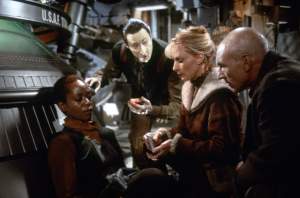Persona 5 Royal

Isbul Pamuji/shutterstock
Persona 5 Royal is the final, deluxe edition of the latest entry in the acclaimed Atlus franchise. Set in a Tokyo high school over one school year, the story follows a group of students who use their newfound special powers to form a secretive vigilante group that seeks to change the hearts of villainous adults.
The narrative is compelling, the gameplay is appropriately complex and satisfyingly addictive, and the relationship-building component between the protagonist and his ever-expanding cadre of companions is charming to explore. Honestly, there’s almost too much game here — a massive 100-hour experience that also begs to be replayed as soon as it’s over to see what other choices you can make.
Pokémon Yellow

BestForLater91/istock
Despite an ever-expanding glossary of Pokemon and an equally expansive number of games in the franchise, the original Pokemon formula ultimately succeeds because of its approachability and the illusion of depth. The game is charmingly simple but allows for tons of personalization, from the naming of each captured Pokemon, to which moves they use and finally which you select to build out your team.
The original Red and Blue versions started it all, but it was Yellow (an enhanced single version of those two titles) that we’re including on this list because it did everything great its predecessors did while adding story beats straight from the anime.
Xenogears

Rachmattt/istock
Xenogears is yet another title that succeeds despite a shaky localization effort and the fact that the development kind of ran out of time and money which led to some…interesting narrative choices on the game’s second disc.
Despite that, the complex and thought-provoking narrative, interesting roster of characters, and the fact that you spend a third of the game smashing enemies in giant, Evangelion-esque mech suits is more than enough to reason call this game as one of the best of the genre. Though the Xenosaga series would later come as a spiritual successor to Xenogears, it remains a disappointment that we were never able to get a true follow-up to the cult classic.
Earthbound

Mihai Gruianu/istock
Also known as Mother 2 in Japan, Earthbound was one of the first RPGs to eschew your typical swords and shields, dungeons, and dragons approach and instead go with a modern setting. The game is effectively a satire of American culture and on top of that one of the most bizarre mainstream releases in Nintendo’s early history. The art style is Peanuts-esque, though it grows more and more bizarre as the player progresses with the final boss being essentially an indescribable Lovecraftian monster. A wholly unique experience, Earthbound is a must-play for anyone who is a fan of turn-based RPGs or the 16-bit era of games more broadly.
Chrono Trigger

Joc Kan/WireImage
Chrono Trigger is arguably the turn-based RPG with the most replayability that has ever been released. There are 13 unique endings to the game, and with the brilliant addition of a New Game+ mode, you are encouraged to play with the game’s time travel mechanics to try and achieve them all.
The story is appropriately epic but doesn’t overstay its welcome, and is somehow filled with moments of high drama without ever feeling like it takes itself too seriously. The roster of characters is each well drawn, and there’s fun in playing with party combinations to find new double and triple-team techniques you can use to your advantage. Not just one of the best RPGs ever made, but one of the best games ever made period.
Fallout 2

Mike Windle/Getty Images for Bethesda
Fallout 2: A Post Nuclear Role Playing Game is that old-school type of RPG that is as immersive and open-ended as it is complex and unforgiving. They quite literally don’t make video games like this anymore. For some people, the barrier to entry is going to be too high. Yet for those who persevere and get used to the game’s quirks and systems, they’ll be treated to an epic adventure full of tough choices, interesting characters, and a deeply dark and absurd sense of humor. It is also fun for fans of the more modern games to see what groups and concepts (like VATs) managed to survive the franchise jump from isometric turn-based RPG into what it is now.
Final Fantasy VI

Roy Rochlin/Getty Images
Final Fantasy VI (originally released as Final Fantasy III in the United States) is an epic in the truest sense of the word. The 16-bit sprite art is some of the best of the era. Same for the soundtrack which features some of the most memorable of a franchise known for great music.
The game also features one of the most shocking late-game twists in the history of the medium.
Spoiler alert: the bad guy wins.
For the rest of the story, amidst the ashes of a destroyed world, you must reassemble your group of heroes and try to set right what once went wrong. It won’t be easy, but the gameplay is so much fun you’ll want to try it anyway.
Undertale

klebercordeiro/istock
It’s hard to pin down Undertale. It is a turn-based RPG, yes, but it also has a combat system that includes elements of bullet-hell games. Like Earthbound, the game has an absurdist sense of humor, but for some, it’s also one of the most deeply moving games they’ve ever played. It is a cult classic, though that same fanbase that sang its praises has also given it something of a bad reputation (just google it).
The game is many things to many people – but it’s also a game everyone should play. Possibly more than once. It does things that are wholly brand new, that push the boundaries of the genre and the medium.
Suikoden II

mederevac/istock
It makes sense that the bonds of friendship would be one of the central themes of a game where one of the central mechanics is locating and recruiting all 108 Stars of Destiny to join your cause. Not all of these characters are usable in combat, though many are. Some provide other benefits, such as expanding your ability to craft weapons or armor. And as your roster grows, so too does your castle. It’s so rewarding watching it transform from a minor base of operations to a bustling hub of activity.
The ability to import your save file from the first Suikoden, which carries over certain choices and brings returning characters in at higher levels and with better gear, is a nice touch as well.
Final Fantasy VII

cachua/shutterstock
In retrospect, it is quite funny how bad the localization was for Final Fantasy VII, considering it now has the legacy of being the game that broadened the appeal of turn-based RPGs among Western audiences. It would appear that the appeal of a hero with spiky blonde hair and a giant sword is more than enough to overcome a couple of text boxes that, on scrutiny, don’t make a lick of sense.
Like Final Fantasy VI, this entry is quite famous for its mid-game twist – something that scarred a generation of weeaboos. There’s more to the game than just that moment though, and if you haven’t yet you should give it a playthrough.







